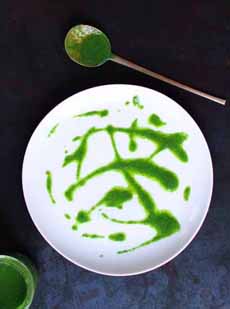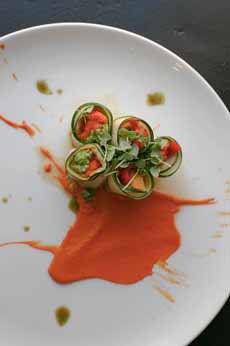TIP OF THE DAY: Jackson Pollock Your Plates
 [1] A drip of basil oil, at Botanica | LA, dripped from a spoon (we use a teaspoon). Place your protein on top, or first add another color.
|
This plate, covered with drips of house-infused basil oil from Botanica LA, inspired us to layer sauces like Jackson Pollock dripped and layered his paints. For almost two decades, creative chefs have been dripping, splashing, dotting, smearing, swirling and zigzagging sauces on the plate before adding the food, both savory and sweet. Today’s tip is to apply the sauce or condiment of the dish to the plate first, instead of spooning it on top of the protein or dessert. While photo #1 shows a one-color drip, you can use different colors for other layers., use a squeeze bottle on others (best for dots, swirls and zigzags). The world may be your oyster*, but the plate is your canvas. 1. Match both the colors and flavors to your dish. You may want something pink, but does Russian dressing go with your scallops? (Maybe it does?) 2. Limit yourself too three colors and space them out. When you layer too much, you’ll get a plate resembling photo #2. 3. Use sauces or condiments with texture. The thinnest condiments don’t work. For example, teriyaki sauce, unless it’s reduced, will not keep its shape on the plate. Tabasco may not work but gochuchang will. Fresh salsa has too much texture to be used for plate painting, but many brands of pasteurized (shelf-stable) salsas are just right. 4. Experiment with different tools. Pollock used a brush; you can use silicone basting or pastry brushes. A squeeze bottle is your friend. To make a splash like photos #3 and #4, put the sauce on a spoon and fling it onto the plate from above. Watch this video: You’ll love what you see—and don’t worry about the “Make Sushi” logo at the beginning. There’s no sushi involved. The difference between the coulis and purée is that a coulis is strained for a finer sauce with no seeds. Here’s more about it. |
|
|
As with vegetables, you can make a fruit coulis or purée in any color you need; e.g., kiwi purée for a green sauce, mango purée for an orange sauce. Another option: melted ice cream in your color of choice. We discovered this years ago, when we accidentally placed a pint of mango sorbet in the fridge instead of the freezer. Ready to have fun? One…two…three: fling! drip! splash! ________________ *The first form of the phrase, “The world is your oyster” first appears in print in Shakespeare’s “The Merry Wives of Windsor,” in a discourse between Falstaff and Pistol, one of his followers: The interpretation of the phrase is that Pistol will use his sword to steal money, referring to the pearl one finds in an oyster. The phrase evolved to mean that the world is yours to enjoy. |
||


